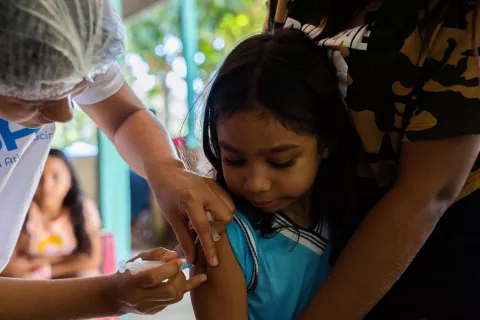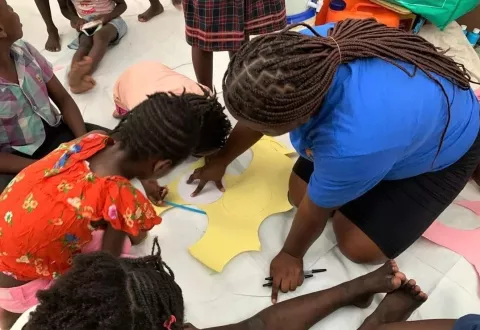UNICEF Latin America and the Caribbean Regional Director Garry Conille's remarks on the Child Alert on child migration in the region at a Press Briefing by the Office of the Spokesperson for the Secretary-General

"Good morning.
"Today, I have the distinct privilege of unveiling the latest UNICEF Child Alert report, focusing on the evolving migration patterns of children and families in Latin America and the Caribbean.
"The purpose of our gathering is twofold: to highlight these critical findings and to underscore the urgency of the situation we are facing.
"The Child Alert on Child Migration in Latin America and the Caribbean, which we are presenting today, unveils a stark and alarming reality: children are now migrating within Latin America and the Caribbean at an unprecedented rate, constituting a larger share of the migrant population than any other region worldwide.
"While migration is not a novel phenomenon in our region, it has undergone a profound transformation over the past decade.
"The situation confronting children on the move in Latin America and the Caribbean is unparalleled in its complexity and scale, demanding immediate attention and decisive action.
"In my role as Regional Director, I have had the privilege of meeting children and families who have embarked on harrowing journeys.
"Their stories are a poignant reminder of the challenges we face.
"From South America to Northern America, from the Caribbean to Central America, an increasing number of children have left behind their homes, schools, friends, and communities.
"Notably, younger children are now undertaking these treacherous journeys with their families, a stark departure from the past.
"The impact of this evolving trend is felt in every corner of our region, with different countries serving as places of origin, transit, and destination, sometimes simultaneously.
"The driving forces behind child migration are numerous and complex, encompassing factors such as rampant gang violence, the escalating effects of climate change, and exacerbated inequalities and poverty, magnified by the COVID-19 pandemic and subsequent lockdowns.
"The children I met shared their arduous journeys, spanning multiple borders and modes of travel, from cars and boats to trucks and trains, but more often than not, on foot.
"Last June, I visited the perilous Darien Jungle, situated between Colombia and Panama—an unforgiving terrain characterized by dense forests, rushing rivers, treacherous hills, and vast swamps. There, I witnessed firsthand the challenges faced by migrant children and families.
"I still very much remember a conversation I had with young family, traveling with a toddler.
"They were crossing a river. The husband was carrying the toddler, who was less than one-year-old and everything else he could carry and his wife was clinging on to his clothes. The wife isn't able to swim.
"A strong current takes her away and the husband has to make a strategic decision as to whether he drops the child to save his wife or keeps holding onto the child and watches his wife drown.
"Fortunately another person traveling dropped everything she had and took the child so the husband was able to save his wife. Two days after the incident he described these moments to me in heartbreaking detail.
"So this is this is significant. And there are many stories likes this.
"In the first half of 2023 alone, over 40,000 children have crossed the perilous Darien Gap on their journey towards Northern America, matching the record number from the entire year of 2022.
"Many of these children have endured loss, be it of belongings, documents, or even family members. These heart-wrenching scenes are repeated throughout the region.
"Moreover, the profile of child migrants is evolving, with children under 11 years of age now comprising up to 91 percent of all children on the move at select key transit points.
"This shift presents unique challenges to national migration policies and humanitarian responses, necessitating tailored services such as breastfeeding spaces for example.
"In Latin America and the Caribbean, migrant and refugee children often encounter significant obstacles when attempting to access essential services critical for their wellbeing.
"Many miss out on education, proper healthcare, and protection—both during their journey and upon arrival at their destination. These challenges can have long-lasting physical and psychosocial repercussions that may hinder their full development and potential.
"So, in the face of this multifaceted and far-reaching crisis, what can be done?
"First, it is imperative to recognize that children on the move and their families possess rights and specific needs, regardless of the reasons for their departure or their legal status. A child remains a child, irrespective of their circumstances. In partnership with governments and civil society organizations, UNICEF is actively engaged in providing life-saving assistance and support to migrant, refugee, and displaced children across 20 countries in Latin America and the Caribbean. Critical areas such as education, health, and child protection systems, in both transit and host countries, are essential for their growth and development.
"Second, we must also all realize that while child migration is often perceived as a challenge, it presents an opportunity to contribute to increased growth, stability, and prosperity in Latin America and the Caribbean.
"Member States in the region can and should take specific actions to safeguard the rights, safety, and wellbeing of migrant and refugee children. This includes enhancing access to services, preventing and addressing violence, investing in child-sensitive border reception and services, ensuring access to legal identity and a regularized status, and promoting integration and participation.
"Third, Child migration in Latin America and the Caribbean transcends national boundaries—it is a continental issue that demands a unified response. All countries in the region can and must work collaboratively to address this multifaceted challenge. States should strive to mobilize a regional approach to international protection and tackle the root causes of child migration.
"This approach should recognize the interconnected nature of migration movements and policy responses in the region and expand safe and regular migration pathways for children and families, including mechanisms for family reunification, all while upholding the right to territorial asylum.
"Regrettably, there is no indication that child migration in Latin America and the Caribbean will abate in the foreseeable future.
"On the contrary, if the root causes—such as gang violence, poverty, and climate change—remain unaddressed, we may witness even more children and families undertaking perilous transcontinental journeys.
"I extend my heartfelt thanks for your attention and am eager to respond to any questions you may have."




